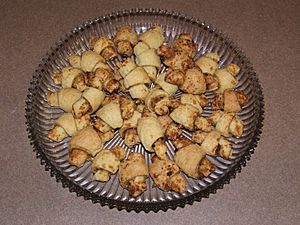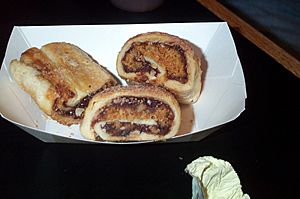Rugelach facts for kids

Chocolate rugelach
|
|
| Type | Pastry |
|---|---|
| Place of origin | Poland |
| Region or state | Central Europe |
| Associated national cuisine | Israel |
| Main ingredients | Dough: sour cream or cream cheese Filling: any of raisins, walnuts, cinnamon, chocolate, marzipan, poppy seed, or fruit preserves |
Rugelach (say "ROO-gəl-əkh") is a delicious baked treat. It's a type of pastry that started in the Jewish communities of Poland. Today, it's very popular in Israel. You can find it in most cafes and bakeries there. It's also a favorite snack for Jewish people living all over the world.
Traditional rugelach are shaped like a crescent moon. Bakers make them by rolling a triangle of dough around a sweet filling. Some people think rugelach and the French croissant are related. They believe both came from crescent-shaped pastries made in Vienna, Austria. These pastries might have celebrated a victory, like the Battle of Vienna in 1683.
However, this story is likely a myth. Rugelach and its older cousin, the Kipferl, existed long before the 1600s. The modern croissant didn't appear until the 1800s. So, it's more likely that the croissant was inspired by these older pastries.
Sometimes, rugelach is made differently. It can be rolled like a strudel or a nut roll. But instead of baking it as one long piece, the rolled dough is cut into slices before baking.
What Does "Rugelach" Mean?
The name "Rugelach" comes from Yiddish. This was the main language of Ashkenazi Jews for many years. The ending "ach" means there's more than one, like saying "s" at the end of a word in English. The "el" part can mean "little."
The word "rugelach" might mean "little twists." This makes sense because of how the pastry is shaped. In Yiddish, "rog" means "corner." In Polish, a language that influenced Yiddish, "róg" can mean "corner" or "horn." Pastries shaped like horns are called "rogale" in Polish. This word sounds very much like "rugelach."
Some people think "rugelach" comes from a Yiddish word meaning "royal." They believe this because the pastry tastes so good! But this idea doesn't quite fit with how Yiddish words are usually formed.
What's Inside Rugelach?
Rugelach dough can be made with sour cream or cream cheese. There are also versions made without dairy products. These are called "pareve" (say "PAR-ev"). This means they can be eaten with or after a meat meal and still follow kosher food rules. Cream cheese dough is a newer way to make rugelach. Older recipes often used yeast or sour cream.
The fillings inside rugelach can be many different things. Popular choices include raisins, walnuts, cinnamon, chocolate, marzipan, poppy seed, or fruit preserves (like jam). In New York, rugelach filled with vanilla have become very popular recently.
Some chefs have even created savory versions of rugelach. These might be filled with chicken and schmaltz (chicken fat) or salmon and boursin cheese.
See also
 In Spanish: Rugelach para niños
In Spanish: Rugelach para niños




